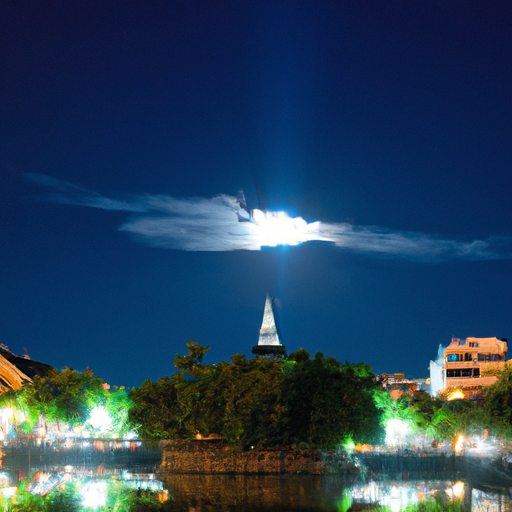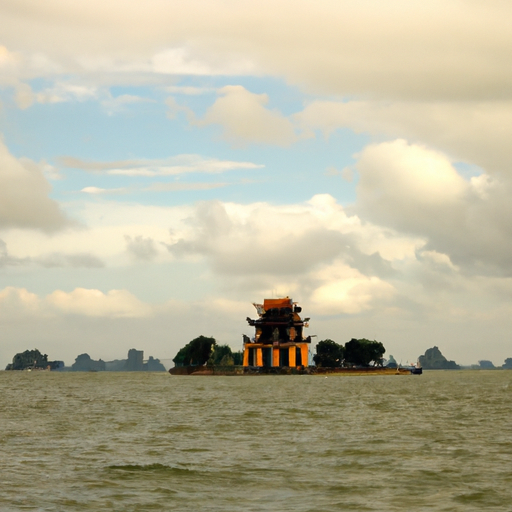In this article, we will explore the rich history of Vietnam. From its ancient origins to the colonial period, and finally, its struggle for independence and reunification, you will learn about the key events and milestones that have shaped Vietnam’s past. We will also delve into the impact of war and how Vietnam has evolved into the vibrant country it is today. So, join me as we take a journey through the fascinating history of Vietnam.
The Early History
Prehistoric Era
The history of Vietnam can be traced back to the prehistoric era, with evidence of early human settlements dating back to at least 7000 BC. These early inhabitants relied on farming, fishing, and hunting for their subsistence. Archaeological discoveries, such as ancient tools and pottery, provide valuable insights into the early civilization of Vietnam.
The Chinese Domination
For centuries, Vietnam faced Chinese domination, which began in the 2nd century BC. Chinese rulers established control over Vietnam and introduced their language, culture, and bureaucratic systems. Vietnamese resistance against Chinese rule led to intermittent periods of independence, but Chinese influence remained strong throughout this era.
The Rise of the Vietnamese Kingdoms
In the 10th century, Vietnam saw the emergence of independent kingdoms, which began to challenge Chinese rule. The Ly Dynasty (1009-1225) and the Tran Dynasty (1225-1400) were significant periods of Vietnamese self-governance. These dynasties focused on strengthening the Vietnamese identity, promoting Confucianism, and expanding trade with neighboring regions.
Colonial Period
European Influence
In the 15th century, European powers arrived in Vietnam, seeking to establish trade routes and exploit its resources. Portuguese, Dutch, and Spanish traders made contact with the Vietnamese, introducing new goods and ideas. The Vietnamese, in turn, adapted these influences into their own culture, incorporating European elements into their traditional customs.
French Conquest
Vietnam came under French colonial rule in the late 19th century. French colonization had a profound impact on Vietnamese society, economy, and politics. The French introduced modern infrastructure, such as railways and roads, but they also exploited Vietnamese resources and imposed heavy taxes. The French language and education system became prevalent, further reinforcing French influence.
Resistance Movements
Resistance against French colonialism intensified in the early 20th century. Vietnamese nationalists, inspired by the ideals of democracy and self-determination, sought to regain their independence. Notable leaders like Phan Boi Chau and Phan Chu Trinh advocated for political reforms and greater Vietnamese autonomy. These efforts laid the groundwork for the future struggle for independence.

Independence Struggle
Ho Chi Minh and the Viet Minh
Ho Chi Minh emerged as the key figure in the fight for Vietnamese independence. Inspired by Marxist ideologies and a strong desire for national freedom, Ho Chi Minh formed the Viet Minh (League for the Independence of Vietnam) in 1941. The Viet Minh orchestrated guerilla warfare and organized uprisings against both the French and Japanese occupiers during World War II.
First Indochina War
The First Indochina War (1946-1954) marked a significant turning point in Vietnam’s fight for independence. The Viet Minh, with support from other nationalist groups, waged a fierce battle against the French. The conflict resulted in a stalemated struggle until the decisive battle of Dien Bien Phu in 1954, where the Viet Minh emerged victorious.
Geneva Accords
The Geneva Accords, signed in 1954, marked the end of French colonial rule and temporarily divided Vietnam into two separate entities: North Vietnam, led by Ho Chi Minh and the communists, and South Vietnam, led by Ngo Dinh Diem and the anti-communists. The intention behind this division was to hold elections to reunify the country, but this goal was never fully realized.
Vietnam War
US Intervention
The Vietnam War, also known as the Second Indochina War, began in the 1960s and lasted until 1975. It was a protracted conflict between North Vietnam, supported by communist allies like China and the Soviet Union, and South Vietnam, supported by the United States and other anti-communist nations. The US involvement escalated over time, with massive military deployments and aerial bombings.
Guerilla Warfare
The Vietnam War saw the utilization of guerilla warfare tactics by the North Vietnamese and the Viet Cong, a communist guerrilla force operating in South Vietnam. The dense jungle terrain and network of underground tunnels known as the Ho Chi Minh Trail provided a strategic advantage to the guerrilla fighters. This unconventional warfare posed significant challenges for the US and its allies.
Tet Offensive
The Tet Offensive in 1968 was a major turning point in the Vietnam War. The North Vietnamese and Viet Cong launched a coordinated series of surprise attacks on multiple cities and military bases in South Vietnam, catching the US and its allies off-guard. Although the offensive was eventually repelled, its psychological impact on the US public led to widespread disillusionment with the war.

Post-War Reconstruction
Reunification of Vietnam
In 1975, North Vietnam’s military offensive resulted in the fall of Saigon, the capital of South Vietnam, and the reunification of the country under communist rule. The Socialist Republic of Vietnam was proclaimed, and the era of post-war reconstruction began. The government faced the enormous task of rebuilding the country’s infrastructure and economy, while also addressing social and political challenges.
Vietnamese Boat People
The aftermath of the Vietnam War saw a significant exodus of Vietnamese refugees, known as the “boat people.” Fleeing the economic hardship and political repression in their homeland, thousands risked their lives in overcrowded boats to seek refuge in neighboring countries or further afield. The international community responded by providing humanitarian aid and resettling many of these refugees.
Market Reforms
In the late 1980s, the Vietnamese government implemented market-oriented economic reforms known as Doi Moi. These reforms aimed to transition Vietnam from a centrally planned economy to a socialist-oriented market economy. The introduction of market mechanisms and foreign investment spurred economic growth and transformed Vietnam into one of the fastest-growing economies in Southeast Asia.
Modern Vietnam
Economic Growth
Over the past few decades, Vietnam has experienced remarkable economic growth and development. The country’s rapid industrialization and export-oriented manufacturing industries have attracted foreign investors and fueled its economic success. Tourism, agriculture, and services sectors have also played significant roles in Vietnam’s ongoing economic transformation.
Social Challenges
Despite the economic progress, Vietnam still faces social challenges. Income inequality, regional disparities, and inadequate social welfare systems remain issues of concern. The government is actively addressing these challenges, striving to improve social safety nets and enhance access to education and healthcare for all citizens.
Political Landscape
Vietnam is a single-party socialist republic, with the Communist Party of Vietnam holding a dominant role in the political system. While there are efforts to promote economic liberalization and limited political reforms, the country remains politically closed, with restrictions on freedom of expression and political dissent. However, evolving social dynamics and generational shifts are gradually shaping the political landscape.
Cultural Heritage
Vietnamese Traditions
Vietnam has a rich cultural heritage that is deeply rooted in its history and traditions. Confucianism and Buddhism have strongly influenced Vietnamese society and values, emphasizing respect for authority, filial piety, and the importance of social harmony. Traditional customs, festivals, and rituals are still integral to Vietnamese culture, connecting the present to its historical past.
Folklore and Legends
Vietnamese folklore and legends often revolve around ancestral heroes, mythical creatures, and folktales passed down through generations. These stories reflect the resilience, bravery, and moral values of the Vietnamese people. Popular legends, such as the story of the Trung Sisters and their fight against Chinese rule, evoke a sense of national pride and identity.
Cuisine and Arts
Vietnamese cuisine is renowned for its fresh ingredients, vibrant flavors, and diverse regional specialties. Pho, spring rolls, and banh mi are among the famous dishes that have gained international popularity. Vietnamese arts, such as traditional music, dance, and water puppetry, embody the country’s cultural heritage and artistic expressions.
Tourism in Vietnam
Popular Destinations
Vietnam’s varied landscapes and rich cultural heritage have made it an increasingly popular tourist destination. From the picturesque mountains of Sapa to the breathtaking beauty of Ha Long Bay, the country offers a wide range of attractions for visitors. Historical sites, such as the Imperial City of Hue and Hoi An Ancient Town, showcase Vietnam’s rich history.
Hanoi and Ho Chi Minh City
Hanoi, the capital city, and Ho Chi Minh City (formerly Saigon) are bustling metropolises that blend tradition with modernity. These cities offer a mix of historical landmarks, vibrant street markets, and a vibrant culinary scene. Visitors can explore the Old Quarter in Hanoi or visit the War Remnants Museum in Ho Chi Minh City to gain a deeper understanding of Vietnam’s history.
Natural Attractions
Vietnam boasts natural attractions that capture the imagination of travelers. From the terraced rice fields of Mu Cang Chai to the pristine beaches of Nha Trang and Danang, the country’s natural beauty is diverse and awe-inspiring. National parks, such as Phong Nha-Ke Bang and Cat Tien, provide opportunities for eco-tourism and wildlife conservation.
Vietnamese Diaspora
Migration Waves
Throughout history, Vietnamese people have migrated to various parts of the world, creating a vibrant Vietnamese diaspora. Large waves of migration occurred after the Vietnam War, with refugees settling in countries like the United States, Canada, France, and Australia. These diaspora communities have retained their Vietnamese heritage and made significant contributions to their adopted countries.
Communities and Contributions
Vietnamese diaspora communities have established themselves in various fields, including business, academia, arts, and politics. Their contributions have enriched the cultural diversity and economic growth of their host countries. Vietnamese-Americans, for example, have thrived in entrepreneurship, while Vietnamese-French individuals have made strides in the arts and literature.
Identity and Adaptation
The Vietnamese diaspora faces the challenge of maintaining their cultural identity while adapting to their new surroundings. Many diaspora members actively engage in preserving their Vietnamese heritage through cultural events, language schools, and community organizations. They bridge the gap between their ancestral homeland and their adopted countries, fostering a sense of shared heritage and pride.
Conclusion
The complex and vibrant history of Vietnam has shaped its present-day society, politics, and culture. From ancient dynasties to modern economic growth, Vietnam’s journey is one of resilience, struggle, and pride. Understanding its history is crucial to comprehending the nation’s identity and aspirations. Today, Vietnam stands as a dynamic and rapidly developing nation, carrying its rich history forward as it shapes its future.

